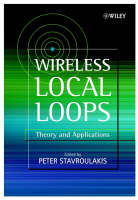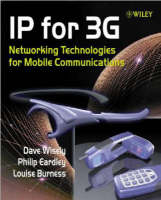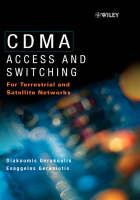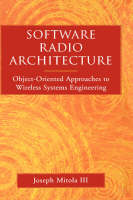Wireless Local Loops
 -15%
portes grátis
-15%
portes grátis
Wireless Local Loops
Theory and Applications
Stavroulakis, Peter
John Wiley & Sons Inc
07/2001
312
Dura
Inglês
9780471498469
15 a 20 dias
662
Descrição não disponível.
List of Contributors xi
Preface xv
Acknowledgement xvii
Part I Theoretical aspects 1
1 Introduction to WLL: Digital Service Technologies 3
1.1 Background 3
1.2 Advantages of Wireless Systems 5
1.3 WLL Service Requirements 6
1.4 Generic WLL System Architecture 9
1.5 WLL System Technologies 14
1.6 Comparison of WLL Services 29
Appendix A Fixed versus Mobile Cellular Systems 30
Appendix B CDMA versus TDMA in WLL 31
References 33
2 Propagation Models for Wireless Local Loops 35
2.1 Introduction 35
2.2 WLL System Configuration 36
2.3 Delay Spread in WLL Environments 37
2.4 Components of Overall Path Loss 39
2.5 Path Loss Models 43
2.6 Comparison of Propagation Models 55
References 55
2 Propagation Models for Wireless Local Loops 35
2.1 Introduction 35
2.2 WLL System Configuration 36
2.3 Delay Spread in WLL Environments 37
2.4 Components of Overall Path Loss 39
2.5 Path Loss Models 43
2.6 Comparison of Propagation Models 55
References 55
3 Wireless Local Loop Networks Capacity Enhancement by Space Division Multiple Access 57
3.1 Introduction 57
3.2 Background 57
3.3 Technologies for the First Generation of Wireless Local Loop 63
3.4 Multiple Access Techniques 70
3.5 Simulation Description 75
3.6 Performance Results 76
References 77
4 Combined Trellis Coded Quantization/Modulation over a Wireless Local Loop Environment 81
4.1 Introduction 81
4.2 Fundamentals of Trellis Coded Modulation 81
4.3 General Aspects of Combined Trellis Coded Quantization Modulation Schemes 83
4.4 Basic Model 88
4.5 An Example: 4-State 8-Psk Combined Trellis Coded Quantization/Modulation 95
References 99
5 Low Sequency W-CDMA Codes Lead to More Economic WLL and Infostation Terminals 101
5.1 Introduction 101
5.2 Code Selection and Generation 104
5.3 Infostation Transmitter 106
5.4 Terminal Receiver 107
5.5 Simplified Signal Processing for a Low Data Terminal 108
5.6 Noise Analysis and Processing Gain 110
References 112
6 Wide-band Wireless Outdoor to Indoor Local Loop Channel Models for Urban and Suburban Environments at 2 GHz 115
6.1 Introduction 115
6.2 Experimental Procedure 116
6.3 Data Processing 120
6.4 Channel Parameters 123
6.5 Channel Model 131
References 139
7 Traffic Considerations in Comparing Access Techniques for WLL 141
7.1 Introduction 141
7.2 Fixed Wireless Access Networks 142
7.3 Multiple Access Technologies 144
7.4 CDMA Capacity Analysis 146
7.5 Comparison of TDMA and CDMA Results 159
List of Abbreviations 161
References 161
8 Traffic Based Dynamic Channel Allocation Schemes for WLL 163
8.1 Introduction 163
8.2 Access on Allocation Technologies 163
8.3 FWA Network Scenarios 168
8.4 Simulations Results of DCA in FWA Networks 178
List of Abbreviations 189
References 190
9 WLL as an Interferer 191
9.1 Introduction 191
9.2 System Overview of WLL as an Interferer 194
9.3 Architecture of WLL as an Interferer 201
9.4 Problem Definition 201
9.5 Description of the Systems 202
9.6 Spectral Characteristics of Signals 210
9.7 Interference Effects Analysis 214
9.8 Study Case 217
References 228
Part II Applications 231
10 Development of a Prototype of the Broadband Radio Access Integrated Network 233
10.1 Introduction 233
10.2 System Overview 234
10.3 MAC Protocol: RS-ISMA 236
10.4 BRAIN Indoor LAN Prototype 240
References 245
11 PBX based Mobility Manager for WLL 247
11.1 Introduction 247
11.2 A Computer-controlled PBX Architecture 247
11.3 Mobility Management for PBX 248
11.4 Registration Procedures 252
11.5 Call Termination 255
11.6 Performance Issues 258
References 260
12 Remote Management and Upgrade in a Wireless Local Loop System 261
12.1 Introduction 261
12.2 Wireless Local Loop Application Overview 262
12.3 Remote Upgrade of Fixed Subscriber Units 263
12.4 Event Logging for Remote Management 266
References 270
13 Current and Future Services Using Wireless Local Loop (WLL) Systems 271
13.1 Introduction 271
13.2 WLL System Architecture 272
13.3 WLL Service Requirements 274
13.4 Services with Currently Available Systems 276
13.5 Further Considerations for Multimedia Services 280
References 281
Index 283
Preface xv
Acknowledgement xvii
Part I Theoretical aspects 1
1 Introduction to WLL: Digital Service Technologies 3
1.1 Background 3
1.2 Advantages of Wireless Systems 5
1.3 WLL Service Requirements 6
1.4 Generic WLL System Architecture 9
1.5 WLL System Technologies 14
1.6 Comparison of WLL Services 29
Appendix A Fixed versus Mobile Cellular Systems 30
Appendix B CDMA versus TDMA in WLL 31
References 33
2 Propagation Models for Wireless Local Loops 35
2.1 Introduction 35
2.2 WLL System Configuration 36
2.3 Delay Spread in WLL Environments 37
2.4 Components of Overall Path Loss 39
2.5 Path Loss Models 43
2.6 Comparison of Propagation Models 55
References 55
2 Propagation Models for Wireless Local Loops 35
2.1 Introduction 35
2.2 WLL System Configuration 36
2.3 Delay Spread in WLL Environments 37
2.4 Components of Overall Path Loss 39
2.5 Path Loss Models 43
2.6 Comparison of Propagation Models 55
References 55
3 Wireless Local Loop Networks Capacity Enhancement by Space Division Multiple Access 57
3.1 Introduction 57
3.2 Background 57
3.3 Technologies for the First Generation of Wireless Local Loop 63
3.4 Multiple Access Techniques 70
3.5 Simulation Description 75
3.6 Performance Results 76
References 77
4 Combined Trellis Coded Quantization/Modulation over a Wireless Local Loop Environment 81
4.1 Introduction 81
4.2 Fundamentals of Trellis Coded Modulation 81
4.3 General Aspects of Combined Trellis Coded Quantization Modulation Schemes 83
4.4 Basic Model 88
4.5 An Example: 4-State 8-Psk Combined Trellis Coded Quantization/Modulation 95
References 99
5 Low Sequency W-CDMA Codes Lead to More Economic WLL and Infostation Terminals 101
5.1 Introduction 101
5.2 Code Selection and Generation 104
5.3 Infostation Transmitter 106
5.4 Terminal Receiver 107
5.5 Simplified Signal Processing for a Low Data Terminal 108
5.6 Noise Analysis and Processing Gain 110
References 112
6 Wide-band Wireless Outdoor to Indoor Local Loop Channel Models for Urban and Suburban Environments at 2 GHz 115
6.1 Introduction 115
6.2 Experimental Procedure 116
6.3 Data Processing 120
6.4 Channel Parameters 123
6.5 Channel Model 131
References 139
7 Traffic Considerations in Comparing Access Techniques for WLL 141
7.1 Introduction 141
7.2 Fixed Wireless Access Networks 142
7.3 Multiple Access Technologies 144
7.4 CDMA Capacity Analysis 146
7.5 Comparison of TDMA and CDMA Results 159
List of Abbreviations 161
References 161
8 Traffic Based Dynamic Channel Allocation Schemes for WLL 163
8.1 Introduction 163
8.2 Access on Allocation Technologies 163
8.3 FWA Network Scenarios 168
8.4 Simulations Results of DCA in FWA Networks 178
List of Abbreviations 189
References 190
9 WLL as an Interferer 191
9.1 Introduction 191
9.2 System Overview of WLL as an Interferer 194
9.3 Architecture of WLL as an Interferer 201
9.4 Problem Definition 201
9.5 Description of the Systems 202
9.6 Spectral Characteristics of Signals 210
9.7 Interference Effects Analysis 214
9.8 Study Case 217
References 228
Part II Applications 231
10 Development of a Prototype of the Broadband Radio Access Integrated Network 233
10.1 Introduction 233
10.2 System Overview 234
10.3 MAC Protocol: RS-ISMA 236
10.4 BRAIN Indoor LAN Prototype 240
References 245
11 PBX based Mobility Manager for WLL 247
11.1 Introduction 247
11.2 A Computer-controlled PBX Architecture 247
11.3 Mobility Management for PBX 248
11.4 Registration Procedures 252
11.5 Call Termination 255
11.6 Performance Issues 258
References 260
12 Remote Management and Upgrade in a Wireless Local Loop System 261
12.1 Introduction 261
12.2 Wireless Local Loop Application Overview 262
12.3 Remote Upgrade of Fixed Subscriber Units 263
12.4 Event Logging for Remote Management 266
References 270
13 Current and Future Services Using Wireless Local Loop (WLL) Systems 271
13.1 Introduction 271
13.2 WLL System Architecture 272
13.3 WLL Service Requirements 274
13.4 Services with Currently Available Systems 276
13.5 Further Considerations for Multimedia Services 280
References 281
Index 283
Este título pertence ao(s) assunto(s) indicados(s). Para ver outros títulos clique no assunto desejado.
greater; terms; geographical; bandwidth; flexibility; new; allocation; subscribers; switches; telephone; signals; radio; network; system; public; pstn; two; communication; experts; local; increasingly important section; brings; loops
List of Contributors xi
Preface xv
Acknowledgement xvii
Part I Theoretical aspects 1
1 Introduction to WLL: Digital Service Technologies 3
1.1 Background 3
1.2 Advantages of Wireless Systems 5
1.3 WLL Service Requirements 6
1.4 Generic WLL System Architecture 9
1.5 WLL System Technologies 14
1.6 Comparison of WLL Services 29
Appendix A Fixed versus Mobile Cellular Systems 30
Appendix B CDMA versus TDMA in WLL 31
References 33
2 Propagation Models for Wireless Local Loops 35
2.1 Introduction 35
2.2 WLL System Configuration 36
2.3 Delay Spread in WLL Environments 37
2.4 Components of Overall Path Loss 39
2.5 Path Loss Models 43
2.6 Comparison of Propagation Models 55
References 55
2 Propagation Models for Wireless Local Loops 35
2.1 Introduction 35
2.2 WLL System Configuration 36
2.3 Delay Spread in WLL Environments 37
2.4 Components of Overall Path Loss 39
2.5 Path Loss Models 43
2.6 Comparison of Propagation Models 55
References 55
3 Wireless Local Loop Networks Capacity Enhancement by Space Division Multiple Access 57
3.1 Introduction 57
3.2 Background 57
3.3 Technologies for the First Generation of Wireless Local Loop 63
3.4 Multiple Access Techniques 70
3.5 Simulation Description 75
3.6 Performance Results 76
References 77
4 Combined Trellis Coded Quantization/Modulation over a Wireless Local Loop Environment 81
4.1 Introduction 81
4.2 Fundamentals of Trellis Coded Modulation 81
4.3 General Aspects of Combined Trellis Coded Quantization Modulation Schemes 83
4.4 Basic Model 88
4.5 An Example: 4-State 8-Psk Combined Trellis Coded Quantization/Modulation 95
References 99
5 Low Sequency W-CDMA Codes Lead to More Economic WLL and Infostation Terminals 101
5.1 Introduction 101
5.2 Code Selection and Generation 104
5.3 Infostation Transmitter 106
5.4 Terminal Receiver 107
5.5 Simplified Signal Processing for a Low Data Terminal 108
5.6 Noise Analysis and Processing Gain 110
References 112
6 Wide-band Wireless Outdoor to Indoor Local Loop Channel Models for Urban and Suburban Environments at 2 GHz 115
6.1 Introduction 115
6.2 Experimental Procedure 116
6.3 Data Processing 120
6.4 Channel Parameters 123
6.5 Channel Model 131
References 139
7 Traffic Considerations in Comparing Access Techniques for WLL 141
7.1 Introduction 141
7.2 Fixed Wireless Access Networks 142
7.3 Multiple Access Technologies 144
7.4 CDMA Capacity Analysis 146
7.5 Comparison of TDMA and CDMA Results 159
List of Abbreviations 161
References 161
8 Traffic Based Dynamic Channel Allocation Schemes for WLL 163
8.1 Introduction 163
8.2 Access on Allocation Technologies 163
8.3 FWA Network Scenarios 168
8.4 Simulations Results of DCA in FWA Networks 178
List of Abbreviations 189
References 190
9 WLL as an Interferer 191
9.1 Introduction 191
9.2 System Overview of WLL as an Interferer 194
9.3 Architecture of WLL as an Interferer 201
9.4 Problem Definition 201
9.5 Description of the Systems 202
9.6 Spectral Characteristics of Signals 210
9.7 Interference Effects Analysis 214
9.8 Study Case 217
References 228
Part II Applications 231
10 Development of a Prototype of the Broadband Radio Access Integrated Network 233
10.1 Introduction 233
10.2 System Overview 234
10.3 MAC Protocol: RS-ISMA 236
10.4 BRAIN Indoor LAN Prototype 240
References 245
11 PBX based Mobility Manager for WLL 247
11.1 Introduction 247
11.2 A Computer-controlled PBX Architecture 247
11.3 Mobility Management for PBX 248
11.4 Registration Procedures 252
11.5 Call Termination 255
11.6 Performance Issues 258
References 260
12 Remote Management and Upgrade in a Wireless Local Loop System 261
12.1 Introduction 261
12.2 Wireless Local Loop Application Overview 262
12.3 Remote Upgrade of Fixed Subscriber Units 263
12.4 Event Logging for Remote Management 266
References 270
13 Current and Future Services Using Wireless Local Loop (WLL) Systems 271
13.1 Introduction 271
13.2 WLL System Architecture 272
13.3 WLL Service Requirements 274
13.4 Services with Currently Available Systems 276
13.5 Further Considerations for Multimedia Services 280
References 281
Index 283
Preface xv
Acknowledgement xvii
Part I Theoretical aspects 1
1 Introduction to WLL: Digital Service Technologies 3
1.1 Background 3
1.2 Advantages of Wireless Systems 5
1.3 WLL Service Requirements 6
1.4 Generic WLL System Architecture 9
1.5 WLL System Technologies 14
1.6 Comparison of WLL Services 29
Appendix A Fixed versus Mobile Cellular Systems 30
Appendix B CDMA versus TDMA in WLL 31
References 33
2 Propagation Models for Wireless Local Loops 35
2.1 Introduction 35
2.2 WLL System Configuration 36
2.3 Delay Spread in WLL Environments 37
2.4 Components of Overall Path Loss 39
2.5 Path Loss Models 43
2.6 Comparison of Propagation Models 55
References 55
2 Propagation Models for Wireless Local Loops 35
2.1 Introduction 35
2.2 WLL System Configuration 36
2.3 Delay Spread in WLL Environments 37
2.4 Components of Overall Path Loss 39
2.5 Path Loss Models 43
2.6 Comparison of Propagation Models 55
References 55
3 Wireless Local Loop Networks Capacity Enhancement by Space Division Multiple Access 57
3.1 Introduction 57
3.2 Background 57
3.3 Technologies for the First Generation of Wireless Local Loop 63
3.4 Multiple Access Techniques 70
3.5 Simulation Description 75
3.6 Performance Results 76
References 77
4 Combined Trellis Coded Quantization/Modulation over a Wireless Local Loop Environment 81
4.1 Introduction 81
4.2 Fundamentals of Trellis Coded Modulation 81
4.3 General Aspects of Combined Trellis Coded Quantization Modulation Schemes 83
4.4 Basic Model 88
4.5 An Example: 4-State 8-Psk Combined Trellis Coded Quantization/Modulation 95
References 99
5 Low Sequency W-CDMA Codes Lead to More Economic WLL and Infostation Terminals 101
5.1 Introduction 101
5.2 Code Selection and Generation 104
5.3 Infostation Transmitter 106
5.4 Terminal Receiver 107
5.5 Simplified Signal Processing for a Low Data Terminal 108
5.6 Noise Analysis and Processing Gain 110
References 112
6 Wide-band Wireless Outdoor to Indoor Local Loop Channel Models for Urban and Suburban Environments at 2 GHz 115
6.1 Introduction 115
6.2 Experimental Procedure 116
6.3 Data Processing 120
6.4 Channel Parameters 123
6.5 Channel Model 131
References 139
7 Traffic Considerations in Comparing Access Techniques for WLL 141
7.1 Introduction 141
7.2 Fixed Wireless Access Networks 142
7.3 Multiple Access Technologies 144
7.4 CDMA Capacity Analysis 146
7.5 Comparison of TDMA and CDMA Results 159
List of Abbreviations 161
References 161
8 Traffic Based Dynamic Channel Allocation Schemes for WLL 163
8.1 Introduction 163
8.2 Access on Allocation Technologies 163
8.3 FWA Network Scenarios 168
8.4 Simulations Results of DCA in FWA Networks 178
List of Abbreviations 189
References 190
9 WLL as an Interferer 191
9.1 Introduction 191
9.2 System Overview of WLL as an Interferer 194
9.3 Architecture of WLL as an Interferer 201
9.4 Problem Definition 201
9.5 Description of the Systems 202
9.6 Spectral Characteristics of Signals 210
9.7 Interference Effects Analysis 214
9.8 Study Case 217
References 228
Part II Applications 231
10 Development of a Prototype of the Broadband Radio Access Integrated Network 233
10.1 Introduction 233
10.2 System Overview 234
10.3 MAC Protocol: RS-ISMA 236
10.4 BRAIN Indoor LAN Prototype 240
References 245
11 PBX based Mobility Manager for WLL 247
11.1 Introduction 247
11.2 A Computer-controlled PBX Architecture 247
11.3 Mobility Management for PBX 248
11.4 Registration Procedures 252
11.5 Call Termination 255
11.6 Performance Issues 258
References 260
12 Remote Management and Upgrade in a Wireless Local Loop System 261
12.1 Introduction 261
12.2 Wireless Local Loop Application Overview 262
12.3 Remote Upgrade of Fixed Subscriber Units 263
12.4 Event Logging for Remote Management 266
References 270
13 Current and Future Services Using Wireless Local Loop (WLL) Systems 271
13.1 Introduction 271
13.2 WLL System Architecture 272
13.3 WLL Service Requirements 274
13.4 Services with Currently Available Systems 276
13.5 Further Considerations for Multimedia Services 280
References 281
Index 283
Este título pertence ao(s) assunto(s) indicados(s). Para ver outros títulos clique no assunto desejado.











